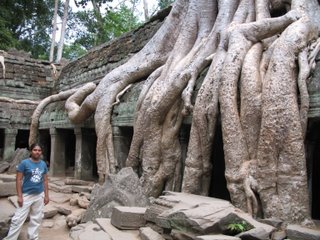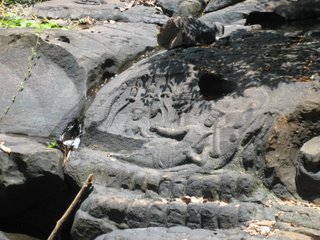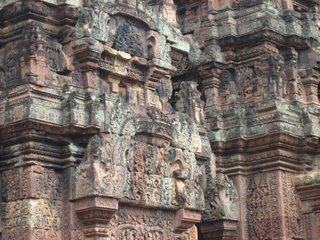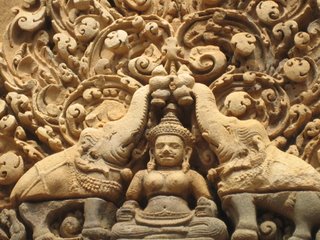


 Well on day 2 we did visit some other sites which were in ruins (of course) and went to the local market. We could see some apsara figures, the Bayon king figures and even lot of ganesha made in wood, metal and stone. We did some shopping of titbits and we were told to bargain upto 40 percent. Here every body understands english and have communicative skills and with their small calculator it was easy to bargain. Of course no need to mention that the trade was strictly in american dollars. I wonder if even in USA so much transaction is done in dollar bills.( As it is just plastic or internet transaction there)
Well on day 2 we did visit some other sites which were in ruins (of course) and went to the local market. We could see some apsara figures, the Bayon king figures and even lot of ganesha made in wood, metal and stone. We did some shopping of titbits and we were told to bargain upto 40 percent. Here every body understands english and have communicative skills and with their small calculator it was easy to bargain. Of course no need to mention that the trade was strictly in american dollars. I wonder if even in USA so much transaction is done in dollar bills.( As it is just plastic or internet transaction there)Well today being day 3 we were heading towards the outskirts of the city about 30 to 40 kms away from the city. One of our friends was very particular about this visit as we were to visit the sahastra linga site.
First on our way we stopped at the site Banteay Srei. (On our way, we saw many more structures and just took pictures as we did not have time.) This is also built in sand stone but here the sand stone has a red hue and has wonderful carvings much better than the angkor group. It has intricate designs which reminded me very much of Belur and Halebidu temples near bangalore. (I have decided to revisit belur and halebidu). This is also in ruins of course.
This was a temple dedicated to siva with a shrine for vishnu and brahma also. But there are no shrines now. We could see the figures of siva and parvathi on nandi the umamaheswara posture, unfortunately the parvati's head is cut. we could see, indra on iravata, the vali sugriva fight, narasimha killing hiranyakasipu and many more carvings. This has only one level.
The scenery is wonderful with big trees, on both sides of road and lot of cashew trees on the way. Our guide was telling us how polpot after his fall was hiding in the forest near here and how this place was full of land mines after the vietnam war ended in the end of seventies. He said there were like 2 mines for each combodians living. Luckily thanks to the organization which Princess Diana took a lot of interest in and other organizations, now almost all of the mines have been removed.
We reached the base of the Kulen mountain. We had to climb up the mountain to a place Kbal Spean where the thousand lingas are found. The guide said it is just half an hours climb. But for some of us it was more than that and the terrain at some places was really tough. We did manage to climb to the top and there initially it was a dissapointment to see the small area in which the lingas are found. Water flows over the lingas which are carved out of the rocks and during rainy season the whole lot of lingas are sumberged in water which could be seen (he said) if there is sunlight. But for us being dry season only little water was flowing over the lingas and we could see carvings on the side rocks of vishnu in his sleeping posture with lakshmi near his foot and also brahma on a lotus from his navel. there was uma maheswara also carved nearby. The visnu with lakshmi was sort of a repetitive theme which could be found on rocks nearby near the stream some five or six of them. Our guide was explaining vishnu with his leg massage lady lakshmi. (there are lot of massage and leg massage centres in Siem Reap). There is a little water fall also. This symbolically represents the Meru mountain and river ganga. So we all had the water sprinkled (prokshana) on our head. To some Australian visitors, one of our friends showed the carvings as otherwise it is not very conspicuous to a normal visitor without a guide.
Getting down was much more tough though it was faster. We had lunch in the base of the hill which was set in a beautiful surrounding just simple tiled roof hall. It had a wonderful orchard which had mangoes just hanging fives and sixes in a bunch and jack fruits all around us. Our guide was so hospitable he wanted us to taste their delicacy. So he had bought gluttonous rice on the way and made them cook it, and had bought some local mangoes. you are too eat the cooked gluttonous rice with the mangoes which is the dessert. It is entirely a different story that we could not wait for the normal rice to arrive as we were hungry and had the gluttonous rice with our great podis and ate mangoes separately. Of course I did try the gluttonous rice with mangoes and it did taste nice. He had bought ' nongu' also on the way and gave it for dessert. One thing is in every restuarant they give fresh cut fruits as dessert. pineapple is also very tasty there. It was pouring very heavily while we were having lunch and lucky that we climbed down before the rain.
We returned to angkor area again and saw another huge complex Preah Khan which was built by jayavarman VII in memory of his father. It is supposed that it was sort of an university or place of higher education at his time. Here we could see some 200 years old mahagony trees.
The next one we saw was Ta Prohm built for queen mother by the same king. This one the building is just interwined with trees, and roots. They have just kept it so that we could understand how the other buildings also were before restoration. This building restoration is being done by the archeological survey of India. We met few officers and when they asked our opinion we said some how the interwining of the trees and the buildings has such a charm which makes it look one of the most beautiful structures in the whole of our tour. So at least some of them have to be kept as it is. They said there plan is some what same as the UNO guidelines also specify this.
In the evening we went to a cultural show in a hotel, where we saw dance performance by group. There was apsara dance and some folk dances also. Just like our kolattam, they did almost with same rythm and movements, dance with polished coconut shells .
Our tour of Angkor was complete and we set out for phnom penh with heavy heart.
2 comments:
Angor la evalavu irukka?Your detailed descriptions really brought the entire scene in front of me as i read it.
what is glutonous rice?I have heard of thai rice.what is this?
ASI is doing consultancy work in Angor vat is welcome news.So the connection between the two countries is re established by restoration.Good good.
glutonous rice is nothing but what they call sticky rice. It sticks! When I was telling anand about this he said this dish is a thai delicacy. May be even the receipes went to Siam from here and they made them world famous.
Post a Comment